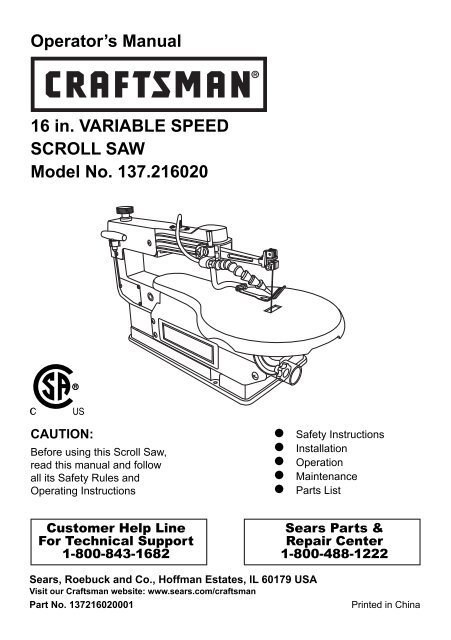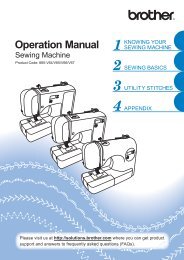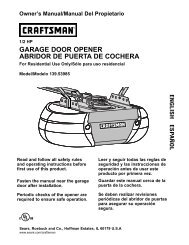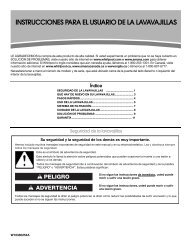Operator's Manual 16 in. VARIABLE SPEED SCROLL SAW ... - Sears
Operator's Manual 16 in. VARIABLE SPEED SCROLL SAW ... - Sears
Operator's Manual 16 in. VARIABLE SPEED SCROLL SAW ... - Sears
Create successful ePaper yourself
Turn your PDF publications into a flip-book with our unique Google optimized e-Paper software.
TABLE OF CONTENTS<br />
SECTION PAGE<br />
Warranty ................................................................................................. 2<br />
Product Specifications ............................................................................ 3<br />
Symbols................................................................................................... 4<br />
Power Tool Safety ................................................................................... 5<br />
Scroll Saw Safety .................................................................................... 8<br />
Electrical Requirements and Safety ........................................................ 10<br />
Accessories and Attachments ................................................................. 12<br />
Tools Needed for Assembly .................................................................... 12<br />
Carton Contents ...................................................................................... 13<br />
Know Your Scroll Saw............................................................................. 14<br />
Glossary of Terms ................................................................................... 15<br />
Assembly and Adjustments ..................................................................... 17<br />
Operation ................................................................................................ 26<br />
Ma<strong>in</strong>tenance ........................................................................................... 31<br />
Troubleshoot<strong>in</strong>g Guide ........................................................................... 32<br />
Parts List ................................................................................................. 34<br />
WARRANTY<br />
CRAFTSMAN ONE YEAR FULL WARRANTY<br />
If this Craftsman tool fails due to a defect <strong>in</strong> material or workmanship with<strong>in</strong><br />
one year from the date of purchase, call 1-800-4-MY-HOME R to arrange for<br />
free repair (or replacement if repair proves impossible).<br />
This warranty applies for only 90 days from the date of purchase if this product<br />
is ever used for commercial or rental purposes.<br />
This warranty does not <strong>in</strong>clude expendable parts, such as lamps, batteries,<br />
bits or blades.<br />
This warranty gives you specific legal rights, and you may also have other<br />
rights which vary from state to state.<br />
<strong>Sears</strong>, Roebuck and Co., Hoffman Estates, IL 60179<br />
! WARNING<br />
Some dust created by us<strong>in</strong>g power tools conta<strong>in</strong>s chemicals known to the state<br />
of California to cause cancer and birth defects or other reproductive harm.<br />
Some examples of these chemicals are:<br />
● Lead from lead-based pa<strong>in</strong>ts<br />
● Crystall<strong>in</strong>e silica from bricks, cement and other masonry products<br />
● Arsenic and chromium from chemically treated lumber<br />
Your risk from these exposures varies, depend<strong>in</strong>g on how often you do<br />
this type of work. To reduce your exposure to these chemicals, work <strong>in</strong> a<br />
well ventilated area and work with approved safety equipment such as dust<br />
masks that are specially designed to filter out microscopic particles.<br />
2<br />
2008/05
PRODUCT SPECIFICATIONS<br />
MOTOR<br />
Power Source ............................................................. 1.6 A, 120 V AC, 60 Hz<br />
Speed Control............................................................. Electric<br />
TABLE<br />
Tilt................................................................................ 45 0 Left<br />
<strong>SAW</strong>DUST BLOWER................................................. Yes<br />
BLADE<br />
Speed.......................................................................... 400~<strong>16</strong>00 SPM<br />
Type............................................................................. P<strong>in</strong>-end or Pla<strong>in</strong>-end<br />
Length.......................................................................... 5 <strong>in</strong>.<br />
Depth of Throat............................................................ <strong>16</strong> <strong>in</strong>.<br />
Blade Stroke................................................................ 3/4 <strong>in</strong>.<br />
Depth of 45 0 Cut.......................................................... 1 <strong>in</strong>.<br />
Depth of 90 0 Cut.......................................................... 2 <strong>in</strong>.<br />
! WARNING<br />
To avoid electrical hazards, fire hazards or damage to the tool, use proper<br />
circuit protection.<br />
This tool is wired at the factory for 110-120 Volt operation. It must be<br />
connected to a 110-120 Volt / 15 Ampere time delay fuse or circuit breaker.<br />
To avoid shock or fire, replace power cord immediately if it is worn, cut or<br />
damaged <strong>in</strong> any way.<br />
Before us<strong>in</strong>g your tool, it is critical that you read and understand these<br />
safety rules. Failure to follow these rules could result <strong>in</strong> serious <strong>in</strong>jury to<br />
you or damage to the tool.<br />
3
WARNING ICONS<br />
Your power tool and its Operator’s <strong>Manual</strong> may conta<strong>in</strong> “WARNING ICONS”<br />
(a picture symbol <strong>in</strong>tended to alert you to, and/or <strong>in</strong>struct you how to avoid,<br />
a potentially hazardous condition). Understand<strong>in</strong>g and heed<strong>in</strong>g these<br />
symbols will help you operate your tool better and safer. Shown below are<br />
some of the symbols you may see.<br />
!<br />
!<br />
!<br />
SAFETY ALERT: Precautions that <strong>in</strong>volve your safety.<br />
PROHIBITION<br />
WEAR EYE PROTECTION: Always wear safety goggles or safety<br />
glasses with side shields.<br />
READ AND UNDERSTAND OPERATOR’S MANUAL: To reduce the risk<br />
of <strong>in</strong>jury, user and all bystanders must read and understand operator’s<br />
manual before us<strong>in</strong>g this product.<br />
KEEP HANDS AWAY FROM BLADE: Failure to keep your hands away<br />
from the blade will result <strong>in</strong> serious personal <strong>in</strong>jury.<br />
SUPPORT AND CLAMP WORK<br />
DANGER<br />
WARNING<br />
CAUTION<br />
CAUTION<br />
SYMBOLS<br />
DANGER: <strong>in</strong>dicates an imm<strong>in</strong>ently hazardous situation<br />
which, if not avoided, will result <strong>in</strong> death or serious <strong>in</strong>jury.<br />
WARNING: <strong>in</strong>dicates a potentially hazardous situation<br />
which, if not avoided, could result <strong>in</strong> death or serious <strong>in</strong>jury.<br />
CAUTION: <strong>in</strong>dicates a potentially hazardous situation which,<br />
if not avoided, may result <strong>in</strong> m<strong>in</strong>or or moderate <strong>in</strong>jury.<br />
CAUTION: used without the safety alert symbol <strong>in</strong>dicates<br />
a potentially hazardous situation which, if not avoided,<br />
may result <strong>in</strong> property damage.<br />
4
POWER TOOL SAFETY<br />
GENERAL SAFETY INSTRUCTIONS<br />
BEFORE USING THIS POWER TOOL<br />
Safety is a comb<strong>in</strong>ation of common<br />
sense, stay<strong>in</strong>g alert and know<strong>in</strong>g how<br />
to use your power tool.<br />
! WARNING<br />
To avoid mistakes that could cause<br />
serious <strong>in</strong>jury, do not plug the tool <strong>in</strong><br />
until you have read and understood<br />
the follow<strong>in</strong>g.<br />
1. READ and become familiar<br />
with the entire Operator’s<br />
<strong>Manual</strong>. LEARN the tool’s<br />
application, limitations and<br />
possible hazards.<br />
2. KEEP GUARDS IN PLACE and <strong>in</strong><br />
work<strong>in</strong>g order.<br />
3. REMOVE ADJUSTING KEYS<br />
AND WRENCHES. Form the habit<br />
of check<strong>in</strong>g to see that keys and<br />
adjust<strong>in</strong>g wrenches are removed<br />
from the tool before turn<strong>in</strong>g ON.<br />
4. KEEP WORK AREA CLEAN.<br />
Cluttered areas and benches <strong>in</strong>vite<br />
accidents.<br />
5. DO NOT USE IN DANGEROUS<br />
ENVIRONMENTS. Do not use<br />
power tools <strong>in</strong> damp locations, or<br />
expose them to ra<strong>in</strong> or snow. Keep<br />
work area well lit.<br />
5<br />
6. KEEP CHILDREN AWAY. All<br />
visitors and bystanders should be<br />
kept a safe distance from work<br />
area.<br />
7. MAKE WORKSHOP CHILD<br />
PROOF with padlocks, master<br />
switches or by remov<strong>in</strong>g starter<br />
keys.<br />
8. DO NOT FORCE THE TOOL. It will<br />
do the job better and safer at the<br />
rate for which it was designed.<br />
9. USE THE RIGHT TOOL. Do not<br />
force the tool or an attachment<br />
to do a job for which it was not<br />
designed.<br />
10. USE PROPER EXTENSION<br />
CORDS. Make sure your extension<br />
cord is <strong>in</strong> good condition. When<br />
us<strong>in</strong>g an extension cord, be sure<br />
to use one heavy enough to carry<br />
the current your product will draw.<br />
An undersized cord will result <strong>in</strong><br />
a drop <strong>in</strong> l<strong>in</strong>e voltage and <strong>in</strong> loss<br />
of power which will cause the tool<br />
to overheat. The table on page<br />
11 shows the correct size to use<br />
depend<strong>in</strong>g on cord length and<br />
nameplate ampere rat<strong>in</strong>g. If <strong>in</strong><br />
doubt, use the next heavier gauge.<br />
The smaller the gauge number, the<br />
heavier the cord.
11. WEAR PROPER APPAREL. Do<br />
not wear loose cloth<strong>in</strong>g, gloves,<br />
neckties, r<strong>in</strong>gs, bracelets or other<br />
jewelry which may get caught <strong>in</strong><br />
mov<strong>in</strong>g parts. Nonslip footwear is<br />
recommended. Wear protective<br />
hair cover<strong>in</strong>g to conta<strong>in</strong> long hair.<br />
12. ALWAYS WEAR EYE<br />
PROTECTION. Any power<br />
tool can throw foreign<br />
objects <strong>in</strong>to the eyes and<br />
could cause permanent<br />
eye damage. ALWAYS wear Safety<br />
Goggles (not glasses) that comply<br />
with ANSI Safety standard Z87.1.<br />
Everyday eyeglasses have only<br />
impact–resistant lenses. They<br />
ARE NOT safety glasses. Safety<br />
Goggles are available at <strong>Sears</strong>.<br />
NOTE: Glasses or goggles not <strong>in</strong><br />
compliance with ANSI Z87.1 could<br />
seriously <strong>in</strong>jure you when they<br />
break.<br />
13. WEAR A FACE MASK OR DUST<br />
MASK. Saw<strong>in</strong>g operation produces<br />
dust.<br />
14. SECURE WORK. Use clamps or<br />
a vise to hold work when<br />
practical. It is safer than<br />
us<strong>in</strong>g your hand and<br />
it frees both hands to<br />
operate the tool.<br />
6<br />
15. DISCONNECT TOOLS FROM<br />
POWER SOURCE before servic<strong>in</strong>g,<br />
and when chang<strong>in</strong>g accessories<br />
such as blades, bits and cutters.<br />
<strong>16</strong>. REDUCE THE RISK OF<br />
UNINTENTIONAL STARTING.<br />
Make sure switch is <strong>in</strong> the OFF<br />
position before plugg<strong>in</strong>g the tool <strong>in</strong>.<br />
17. USE RECOMMENDED<br />
ACCESSORIES. Consult<br />
this Operator’s <strong>Manual</strong> for<br />
recommended accessories. The<br />
use of improper accessories may<br />
cause risk of <strong>in</strong>jury to yourself or<br />
others.<br />
18. NEVER STAND ON THE TOOL.<br />
Serious <strong>in</strong>jury could occur if the<br />
tool is tipped or if the cutt<strong>in</strong>g tool is<br />
un<strong>in</strong>tentionally contacted.<br />
19. CHECK FOR DAMAGED PARTS.<br />
Before further use of the tool, a<br />
guard or other part that is damaged<br />
should be carefully checked to<br />
determ<strong>in</strong>e that it will operate<br />
properly and perform its <strong>in</strong>tended<br />
function – check for alignment of<br />
mov<strong>in</strong>g parts, b<strong>in</strong>d<strong>in</strong>g of mov<strong>in</strong>g<br />
parts, breakage of parts, mount<strong>in</strong>g<br />
and any other conditions that may<br />
affect its operation. A guard or<br />
other part that is damaged should<br />
be properly repaired or replaced.
20. NEVER LEAVE THE TOOL<br />
RUNNING UNATTENDED. TURN<br />
THE POWER “OFF”. Do not walk<br />
away from a runn<strong>in</strong>g tool until the<br />
blade comes to a complete stop<br />
and the tool is unplugged from the<br />
power source.<br />
21. DO NOT OVERREACH. Keep<br />
proper foot<strong>in</strong>g and balance at all<br />
times.<br />
22. MAINTAIN TOOLS WITH CARE.<br />
Keep tools sharp and clean for best<br />
and safest performance. Follow<br />
<strong>in</strong>structions for lubricat<strong>in</strong>g and<br />
chang<strong>in</strong>g accessories.<br />
23. WARNING: Dust generated from<br />
certa<strong>in</strong> materials can be hazardous<br />
to your health. Always operate saw<br />
<strong>in</strong> well-ventilated area and provide<br />
for proper dust removal.<br />
24. !<br />
DANGER People<br />
with electronic devices, such as<br />
pacemakers, should consult their<br />
physician(s) before us<strong>in</strong>g this<br />
product. Operation of electrical<br />
equipment <strong>in</strong> close proximity to<br />
a heart pacemaker could cause<br />
<strong>in</strong>terference or failure of the<br />
pacemaker.<br />
7
<strong>SCROLL</strong> <strong>SAW</strong> SAFETY<br />
1. READ AND UNDERSTAND all<br />
safety <strong>in</strong>structions and operat<strong>in</strong>g<br />
procedures throughout the manual.<br />
2. DO NOT OPERATE the Scroll Saw<br />
until it is completely assembled<br />
and <strong>in</strong>stalled accord<strong>in</strong>g to the<br />
<strong>in</strong>structions.<br />
3. SHOULD any part of Scroll Saw<br />
be miss<strong>in</strong>g, damaged, or fail <strong>in</strong> any<br />
way, or any electrical component<br />
fail to perform properly, shut off the<br />
switch and remove the plug from<br />
the power supply outlet. Replace<br />
miss<strong>in</strong>g, damaged, or failed parts<br />
before resum<strong>in</strong>g operation.<br />
4. IF YOU ARE NOT thoroughly<br />
familiar with the operation of a<br />
Scroll Saw, obta<strong>in</strong> advice from<br />
your supervisor, <strong>in</strong>structor or other<br />
qualified person.<br />
5. SERIOUS INJURY could occur if<br />
the tool tips over or you accidentally<br />
hit the cutt<strong>in</strong>g tool. Do not store<br />
anyth<strong>in</strong>g above or near the tool.<br />
6. AVOID INJURY from unexpected<br />
saw movement. Place the saw on<br />
a firm level surface where the saw<br />
does not rock and bolt or clamp the<br />
saw to its support.<br />
8<br />
7. YOUR <strong>SCROLL</strong> <strong>SAW</strong> MUST<br />
BE SECURELY FASTENED to<br />
a stand or workbench. If there<br />
is any tendency for the stand<br />
or workbench to move dur<strong>in</strong>g<br />
operation, the stand or workbench<br />
MUST be fastened to the floor.<br />
8. THIS <strong>SCROLL</strong> <strong>SAW</strong> is <strong>in</strong>tended for<br />
<strong>in</strong>door use only.<br />
9. TENSION BLADE PROPERLY<br />
before start<strong>in</strong>g the saw. Recheck<br />
and adjust tension as needed.<br />
10. BLADE TEETH MUST POINT<br />
downward toward the table.<br />
11. TABLE MUST BE CLEARED of all<br />
debris before operat<strong>in</strong>g saw. Do not<br />
perform lay out, set up or assemble<br />
work on the table when the saw is<br />
<strong>in</strong> operation.<br />
12. TO PREVENT INJURIES, avoid<br />
awkward hand or f<strong>in</strong>ger positions,<br />
where a sudden slip could cause a<br />
hand to move <strong>in</strong>to the blade when<br />
operat<strong>in</strong>g the saw.<br />
13. HOLD WORKPIECE FIRMLY<br />
aga<strong>in</strong>st the table top.<br />
14. NEVER CUT MATERIAL that is too<br />
small to be held safely.<br />
15. DO NOT USE dull or bent blades.
<strong>16</strong>. TURN THE <strong>SAW</strong> OFF AND<br />
UNPLUG THE CORD if the blade<br />
b<strong>in</strong>ds <strong>in</strong> the saw kerf while be<strong>in</strong>g<br />
backed out of the workpiece,<br />
usually caused by sawdust<br />
clogg<strong>in</strong>g the kerf. If this happens,<br />
turn off the scroll saw and unplug<br />
the power cord. Wedge open the<br />
kerf and back the blade out of the<br />
workpiece.<br />
17. DO NOT feed the material too<br />
fast while cutt<strong>in</strong>g. Only feed the<br />
workpiece at the rate the saw will<br />
cut.<br />
18. TURN THE POWER OFF, remove<br />
the switch key and make sure the<br />
scroll saw comes to a complete<br />
stop before <strong>in</strong>stall<strong>in</strong>g or remov<strong>in</strong>g<br />
an accessory, and before leav<strong>in</strong>g<br />
the work area.<br />
19. DO NOT START the saw with<br />
workpiece press<strong>in</strong>g aga<strong>in</strong>st the<br />
blade. Slowly feed the workpiece<br />
<strong>in</strong>to the mov<strong>in</strong>g blade.<br />
20. WHEN CUTTING a large<br />
workpiece, MAKE SURE the<br />
material is supported at table<br />
height.<br />
21. EXERCISE CAUTION when<br />
cutt<strong>in</strong>g workpieces that are round<br />
or irregularly shaped. Round items<br />
will roll and irregularly shaped<br />
workpieces can p<strong>in</strong>ch the blade.<br />
9<br />
22. ALWAYS release blade tension<br />
before loosen<strong>in</strong>g the blade holder<br />
screw.<br />
23. MAKE CERTAIN table tilt<strong>in</strong>g lock<br />
is tightened before start<strong>in</strong>g the<br />
mach<strong>in</strong>e.<br />
24. NEVER REACH under the scroll<br />
saw table when motor is runn<strong>in</strong>g.<br />
25. CHECK FOR DAMAGED PARTS<br />
before each use. Check for<br />
alignment of mov<strong>in</strong>g parts, b<strong>in</strong>d<strong>in</strong>g<br />
of mov<strong>in</strong>g parts, breakage of parts,<br />
mount<strong>in</strong>g or any other conditions<br />
that may affect operation. Parts that<br />
are damaged should be properly<br />
repaired or replaced before us<strong>in</strong>g<br />
the tool.<br />
26. THINK SAFETY.
ELECTRICAL REQUIREMENTS AND SAFETY<br />
GROUNDING INSTRUCTIONS<br />
IN THE EVENT OF A MALFUNCTION<br />
OR BREAKDOWN, ground<strong>in</strong>g provides<br />
a path of least resistance for electric<br />
currents and reduces the risk of electric<br />
shock. This tool is equipped with an<br />
electrical cord that has an equipmentground<strong>in</strong>g<br />
conductor and a ground<strong>in</strong>g<br />
plug. The plug must be plugged <strong>in</strong>to<br />
a match<strong>in</strong>g receptacle that is properly<br />
<strong>in</strong>stalled and grounded <strong>in</strong> accordance<br />
with all local codes and ord<strong>in</strong>ances.<br />
DO NOT MODIFY THE PLUG<br />
PROVIDED. If it will not fit the<br />
receptacle, have the proper receptacle<br />
<strong>in</strong>stalled by a qualified electrician.<br />
IMPROPER CONNECTION of the<br />
equipment ground<strong>in</strong>g conductor can<br />
result <strong>in</strong> risk of electric shock. The<br />
conductor with the green <strong>in</strong>sulation<br />
(with or without yellow stripes) is the<br />
equipment ground<strong>in</strong>g conductor. If<br />
repair or replacement of the electrical<br />
cord or plug is necessary, do not<br />
connect the equipment ground<strong>in</strong>g<br />
conductor to a live term<strong>in</strong>al.<br />
CHECK with a qualified electrician or<br />
service person if you do not completely<br />
understand the ground<strong>in</strong>g <strong>in</strong>structions,<br />
or if you are not certa<strong>in</strong> the tool is<br />
properly grounded.<br />
USE only three-wire extension cords<br />
that have three-pronged ground<strong>in</strong>g<br />
plugs with three-pole receptacles that<br />
accept the tool’s plug. Repair or replace<br />
damaged or worn cords immediately.<br />
10<br />
GUIDELINES FOR EXTENSION<br />
CORDS<br />
USE THE PROPER EXTENSION<br />
CORD. Make sure your extension cord<br />
is <strong>in</strong> good condition. Use an extension<br />
cord heavy enough to carry the current<br />
your product will draw. An undersized<br />
cord will cause a drop <strong>in</strong> l<strong>in</strong>e voltage<br />
result<strong>in</strong>g <strong>in</strong> loss of power, overheat<strong>in</strong>g<br />
and burn<strong>in</strong>g out of the motor. The<br />
table on the right shows the correct<br />
size to use depend<strong>in</strong>g on cord length<br />
and nameplate ampere rat<strong>in</strong>g. If <strong>in</strong><br />
doubt, use the next heavier gauge. The<br />
smaller the gauge number, the heavier<br />
the cord.<br />
Make sure your extension cord is<br />
properly wired and <strong>in</strong> good condition.<br />
Always replace a damaged extension<br />
cord or have it repaired by a qualified<br />
technician before us<strong>in</strong>g it. Protect your<br />
extension cords from sharp objects,<br />
excessive heat and damp or wet areas.<br />
Use a separate electrical circuit for<br />
your tool. This circuit must not be less<br />
than #18 wire with a 1.6 A time-lag<br />
fuse. NOTE: When us<strong>in</strong>g an extension<br />
cord on a circuit with a #18 wire, the<br />
extension cord must not exceed 25 feet<br />
<strong>in</strong> length. Before connect<strong>in</strong>g the motor<br />
to the power l<strong>in</strong>e, make sure the switch<br />
is <strong>in</strong> the off position and the electric<br />
current is rated the same as the current<br />
stamped on the motor nameplate.<br />
Runn<strong>in</strong>g at a lower voltage will damage
the motor. This tool is <strong>in</strong>tended for use<br />
on a circuit that has a receptacle like<br />
the one illustrated <strong>in</strong> Fig. 1.<br />
Fig. 1 shows a three-pronged electrical<br />
plug and receptacle that has a<br />
ground<strong>in</strong>g conductor. If a properly<br />
grounded receptacle is not available,<br />
an adapter (sold separately) (Fig. 2)<br />
can be used to temporarily connect<br />
this plug to a two-contact grounded<br />
receptacle. The adapter (Fig. 2) has a<br />
rigid lug extend<strong>in</strong>g from it that MUST<br />
be connected to a permanent earth<br />
ground, such as a properly grounded<br />
receptacle box.<br />
CAUTION<br />
● In all cases, make certa<strong>in</strong> the<br />
receptacle is properly grounded. If<br />
you are not sure, have a qualified<br />
electrician check the receptacle.<br />
● This tool is for <strong>in</strong>door use only.<br />
Do not expose to ra<strong>in</strong> or use <strong>in</strong><br />
damp locations.<br />
● This tool must be grounded while<br />
<strong>in</strong> use to protect the operator from<br />
electric shock.<br />
● Never remove the ground<strong>in</strong>g<br />
prong from the power cord. If<br />
damaged, discont<strong>in</strong>ue use of unit<br />
and contact customer service for<br />
a replacement cord.<br />
11<br />
Fig. 1<br />
Three-Pronged Plug<br />
Ground<strong>in</strong>g Prong<br />
Properly Grounded<br />
Three-Pronged Receptacle<br />
Fig. 2<br />
Ground<strong>in</strong>g Lug Make sure this is<br />
connected to a<br />
known ground.<br />
Adapter<br />
Two-Pronged<br />
Receptacle<br />
MINIMUM GAUGE FOR EXTENSION CORDS (AWG)<br />
(When us<strong>in</strong>g 120 volts only)<br />
Ampere Rat<strong>in</strong>g Total length of Cord<br />
More Than Not More Than 25ft. 50ft. 100ft. 150ft.<br />
0 6 18 <strong>16</strong> <strong>16</strong> 14<br />
6 10 18 <strong>16</strong> 14 12<br />
10 12 <strong>16</strong> <strong>16</strong> 14 12<br />
12 <strong>16</strong> 14 12 Not Recommended
ACCESSORIES AND<br />
ATTACHMENTS<br />
AVAILABLE ACCESSORIES<br />
! WARNING<br />
● To avoid <strong>in</strong>jury, do not attempt<br />
to modify this tool or create<br />
accessories not recommended<br />
for use with this tool. Any such<br />
alteration or modification is<br />
misuse and could result <strong>in</strong> a<br />
hazardous condition lead<strong>in</strong>g to<br />
possible serious <strong>in</strong>jury.<br />
● Use only accessories<br />
recommended for this scroll<br />
saw. Follow <strong>in</strong>structions that<br />
accompany accessories. Use of<br />
improper accessories may cause<br />
hazards.<br />
Visit your <strong>Sears</strong> Hardware Department<br />
or see the <strong>Sears</strong> Power and Hand Tool<br />
Catalog for the follow<strong>in</strong>g accessories:<br />
ITEM<br />
P<strong>in</strong>-end saw blades<br />
Pla<strong>in</strong>-end saw blades<br />
<strong>Sears</strong> may recommend other<br />
accessories not listed <strong>in</strong> this manual.<br />
See your nearest <strong>Sears</strong> store or<br />
Power and Hand Tool Catalog for other<br />
accessories.<br />
Do not use any accessory unless you<br />
have completely read the <strong>in</strong>struction or<br />
Operator’s <strong>Manual</strong> for that accessory.<br />
12<br />
TOOLS NEEDED FOR ASSEMBLY<br />
AND ADJUSTMENT<br />
Supplied<br />
3 mm T-Wrench<br />
Not Supplied<br />
Adjustable Wrench<br />
Comb<strong>in</strong>ation Square<br />
Phillips Screwdriver<br />
5 mm Hex Wrench
UNPACKING AND CHECKING<br />
CONTENTS<br />
CARTON CONTENTS<br />
! WARNING<br />
● To avoid <strong>in</strong>jury, if any part is<br />
miss<strong>in</strong>g or damaged, do not plug<br />
the scroll saw <strong>in</strong> until the miss<strong>in</strong>g<br />
or damaged part is replaced, and<br />
assembly is complete.<br />
● To avoid fire and toxic reaction,<br />
never use gasol<strong>in</strong>e, naphtha,<br />
acetone, lacquer, th<strong>in</strong>ner or<br />
similar highly volatile solvents to<br />
clean the scroll saw.<br />
P<strong>in</strong>-end saw blade Pla<strong>in</strong>-end<br />
saw blades<br />
Scroll Saw<br />
13<br />
1. Remove the scroll saw from the<br />
carton by lift<strong>in</strong>g the saw by the back<br />
of the upper frame.<br />
2. Place the saw on a secure<br />
stationary work surface.<br />
3. Separate all parts from the pack<strong>in</strong>g<br />
material. Check each one with the<br />
illustration below to make certa<strong>in</strong><br />
all items are accounted for before<br />
discard<strong>in</strong>g any pack<strong>in</strong>g material.<br />
CAUTION: Do not lift this saw by the<br />
arm that holds the blade, this may<br />
result <strong>in</strong> damage to the tool.<br />
Dust port<br />
adapter<br />
3 mm T-wrench
T-Wrench<br />
T-Wrench Holder<br />
Blade Guard Foot<br />
Lock Knob<br />
KNOW YOUR <strong>SCROLL</strong> <strong>SAW</strong><br />
Blade Holder Lock Screw<br />
Mount<strong>in</strong>g Holes<br />
Sawdust Blower<br />
ON/OFF Switch<br />
Variable Speed<br />
Control Knob<br />
Bevel Scale<br />
Sawdust Blower Tub<strong>in</strong>g<br />
Mount<strong>in</strong>g Holes<br />
14<br />
Upper Arm<br />
Table Lock Knob<br />
Bellows Seat<br />
Motor<br />
Blade Guard Foot<br />
Worktable<br />
Sawdust<br />
Collection Port<br />
Tension Knob<br />
Blade Storage
<strong>SCROLL</strong> <strong>SAW</strong> TERMS<br />
GLOSSARY OF TERMS<br />
BEVEL SCALE – Represents the<br />
degree of table angle from 0° to 45°<br />
when the table is tilted for bevel cutt<strong>in</strong>g.<br />
BLADE GUARD FOOT – Guards the<br />
blade and keeps your workpiece from<br />
ris<strong>in</strong>g. Helps protect f<strong>in</strong>gers from blade<br />
contact.<br />
BLADE GUARD FOOT LOCK KNOB<br />
– Allows you to raise or lower the foot<br />
and lock it at the desired height.<br />
BLADE HOLDERS – Reta<strong>in</strong> and<br />
position the blades.<br />
BLADE STORAGE – Provides<br />
convenient easy access to extra blades<br />
or wrenches.<br />
QUICK RELEASE TENSION LEVER<br />
– Quickly loosens and retightens<br />
the blade to its orig<strong>in</strong>al tension. The<br />
tension lever quickly sets and resets<br />
the blade tension when perform<strong>in</strong>g<br />
<strong>in</strong>terior cutt<strong>in</strong>g operations or chang<strong>in</strong>g<br />
blades.<br />
<strong>SAW</strong>DUST BLOWER – Keeps<br />
sawdust from cover<strong>in</strong>g the l<strong>in</strong>e of sight<br />
for more accurate cuts. The best results<br />
occur when the blower tube is directed<br />
toward the blade and workpiece.<br />
<strong>SAW</strong>DUST COLLECTION PORT –<br />
Allows vacuum hose or attachments to<br />
15<br />
be used to remove the sawdust from<br />
under the table and base.<br />
TABLE LOCK KNOB – Securely locks<br />
the table at the angle desired for bevel<br />
cutt<strong>in</strong>g.<br />
<strong>VARIABLE</strong> <strong>SPEED</strong> CONTROL<br />
KNOB – Variable switch dial allows<br />
greater versatility when cutt<strong>in</strong>g a<br />
variety of materials. Adjust the speed<br />
to the desired sett<strong>in</strong>g, between 400<br />
to <strong>16</strong>00 strokes per m<strong>in</strong>ute (SPM), by<br />
turn<strong>in</strong>g the control knob clockwise or<br />
counterclockwise.<br />
WOODWORKING TERMS<br />
BLADE TOOTH SET – The total width<br />
the blade will cut based on the distance<br />
from the outside po<strong>in</strong>t of one bent tooth<br />
to the outside po<strong>in</strong>t of the next bent<br />
tooth establish<strong>in</strong>g set of teeth.<br />
DEFLECTION – Slight movement of<br />
blade <strong>in</strong> the horizontal direction while<br />
the blade is mov<strong>in</strong>g <strong>in</strong>l<strong>in</strong>e dur<strong>in</strong>g cutt<strong>in</strong>g<br />
operation. This may be caused by the<br />
blade follow<strong>in</strong>g the gra<strong>in</strong> or the path of<br />
least resistance.<br />
FEED – Rate of mov<strong>in</strong>g material to be<br />
cut <strong>in</strong>to the blade.<br />
KERF – The slot cut by the blade.
LEADING EDGE – The front edge of<br />
the workpiece that is guided <strong>in</strong>to the<br />
blade.<br />
<strong>SAW</strong> BLADE PATH – Area or l<strong>in</strong>e of<br />
sight of the workpiece mov<strong>in</strong>g <strong>in</strong> l<strong>in</strong>e<br />
toward the saw blade edge.<br />
SURFACE – Top of workpiece be<strong>in</strong>g<br />
cut.<br />
TRAILING EDGE – The end of the<br />
workpiece edge last cut by the saw<br />
blade.<br />
WORKPIECE – Material on which the<br />
cutt<strong>in</strong>g operation is be<strong>in</strong>g performed.<br />
Lead<strong>in</strong>g edge<br />
Kerf<br />
Surface<br />
Workpiece<br />
Saw blade path<br />
Trail<strong>in</strong>g edge<br />
<strong>16</strong>
Estimated Assembly Time: 5-10<br />
m<strong>in</strong>utes<br />
!<br />
To avoid <strong>in</strong>jury, do not connect this<br />
scroll saw to the power source until<br />
it is completely assembled and<br />
adjusted and you have read and<br />
understood this <strong>in</strong>struction manual.<br />
MOUNTING <strong>SCROLL</strong> <strong>SAW</strong> TO WORK<br />
SURFACE (FIG. A)<br />
1. If mount<strong>in</strong>g the scroll saw to a<br />
workbench, a solid wood bench is<br />
preferred over a plywood board to<br />
reduce noise and vibration.<br />
2. The hardware to mount this saw<br />
is NOT supplied with the saw. The<br />
hardware as shown <strong>in</strong> Fig. A should<br />
be used:<br />
Fig. A<br />
ASSEMBLY AND ADJUSTMENTS<br />
WARNING<br />
1<br />
5<br />
2 2<br />
4<br />
6<br />
1. (3) Hex head bolts; length as<br />
required<br />
2. (6) Flat washers<br />
3. (1) Foam pad or carpet (optional)<br />
4. (3) Lock washers<br />
5. (3) Hex nuts<br />
6. (3) Jam nuts<br />
3<br />
17<br />
STORING THE T-WRENCH (FIG. B)<br />
The left rear side of the body (1) has a<br />
U-Shaped clamp holder (2) designed<br />
to store the T-wrench (3). Position the<br />
shaft of the T-wrench handle <strong>in</strong>to the<br />
U-shaped clamp holder as shown.<br />
3<br />
2<br />
1<br />
Fig. B<br />
BLADE STORAGE (FIG. C)<br />
The blade storage (1) is located on the<br />
right rear side of the scroll saw body.<br />
The blade storage can conveniently<br />
store extra P<strong>in</strong>-end and Pla<strong>in</strong>-end<br />
blades.<br />
Fig. C<br />
1
THE DUST BLOWER (FIG. D)<br />
1. Locate the sawdust blower tub<strong>in</strong>g (1).<br />
2. Connect the PVC plastic end of the<br />
tube to the bellows seat (2).<br />
3. For best results, the dust blower<br />
tube should be adjusted to direct air<br />
at both the blade and the workpiece.<br />
Fig. D<br />
1<br />
<strong>SAW</strong>DUST COLLECTION PORT (FIG.<br />
E, F)<br />
This scroll saw will accept a hose or<br />
vacuum accessory (not provided)<br />
to be connected to the sawdust<br />
collection port (1) on the front of<br />
base. If excessive sawdust buildup<br />
occurs <strong>in</strong>side the base, use a wet/dry<br />
vacuum cleaner or manually remove<br />
sawdust by first unplugg<strong>in</strong>g the saw<br />
from the power source, then remov<strong>in</strong>g<br />
the three screws (2) on the left side<br />
of saw hold<strong>in</strong>g the plate cover. After<br />
clean<strong>in</strong>g all sawdust buildup, reattach<br />
the plate and screws before restart<strong>in</strong>g<br />
the saw. This will keep your saw cutt<strong>in</strong>g<br />
efficiently.<br />
2<br />
18<br />
2<br />
Fig. E<br />
! WARNING<br />
● To prevent fire hazard, clean and<br />
remove sawdust from under the<br />
saw frequently.<br />
● To prevent sawdust build up <strong>in</strong>side<br />
the saw hous<strong>in</strong>g, attach a vacuum<br />
hose (3) to the sawdust collection<br />
port (1) at the front of the scroll<br />
saw. DO NOT operate the saw<br />
with the hose <strong>in</strong> place unless the<br />
vacuum is turned on.<br />
NOTE: A 43-38 mm (1-11/<strong>16</strong> <strong>in</strong>-1-1/2<br />
<strong>in</strong>) dust port adapter (4) is provided for<br />
your convenience.<br />
Fig. F<br />
4<br />
3<br />
1<br />
1
BLADE REMOVAL AND<br />
INSTALLATION<br />
PIN-END BLADE REMOVAL AND<br />
INSTALLATION<br />
! WARNING<br />
To prevent personal <strong>in</strong>jury, always<br />
turn the saw OFF and disconnect the<br />
plug from source before chang<strong>in</strong>g<br />
blades or mak<strong>in</strong>g adjustments.<br />
P<strong>in</strong>-end type blades are thicker for<br />
stability and for faster assembly. These<br />
blades are used whenever faster<br />
cutt<strong>in</strong>g on a variety of materials and 3/4<br />
<strong>in</strong>. thickness or greater are required.<br />
Use whenever less precision or thicker<br />
kerf cutt<strong>in</strong>g is acceptable.<br />
NOTE: When <strong>in</strong>stall<strong>in</strong>g p<strong>in</strong>-end blades,<br />
the set screws located on the upper<br />
and lower blade holders should not be<br />
over or under tightened. The slot must<br />
be slightly wider than the thickness of<br />
the blade. After the blade is <strong>in</strong>stalled,<br />
the blade tension mechanism will keep<br />
the p<strong>in</strong>-end <strong>in</strong> place.<br />
PIN-END BLADE REMOVAL (FIG. G,<br />
H)<br />
1. Loosen the tension on the blade<br />
by turn<strong>in</strong>g the tension knob<br />
counterclockwise. (Fig. G).<br />
Fig. G<br />
19<br />
2. Remove the blade (2) from the<br />
upper (3) and lower (4) blade holder<br />
by pull<strong>in</strong>g blade forward to release,<br />
and lift the blade through the access<br />
hole. (Fig. H)<br />
NOTE:<br />
● Apply slight downward pressure<br />
on the upper arm when remov<strong>in</strong>g<br />
the blade from the upper blade<br />
holder.<br />
● If the tension is still too tight to<br />
remove blade, turn the tension<br />
lever (Fig. G) counterclockwise<br />
no more than one rotation. (Do<br />
not over-loosen.)<br />
Fig. H<br />
3<br />
2<br />
4<br />
2
PIN-END BLADE INSTALLATION<br />
(FIG. I, J, K)<br />
NOTE: Do not tighten the set screw (1,<br />
2) when us<strong>in</strong>g P<strong>in</strong>-end blades. (Fig. J)<br />
! WARNING<br />
In order to avoid uncontrollable<br />
lift<strong>in</strong>g of the workpiece, the teeth<br />
of the blade MUST ALWAYS po<strong>in</strong>t<br />
downward. (Fig. I)<br />
Fig. I<br />
1. Install the blade (3) by <strong>in</strong>sert<strong>in</strong>g one<br />
end of it through the access hole (4)<br />
of throat plate <strong>in</strong> the table. Hook the<br />
lower blade p<strong>in</strong> <strong>in</strong> the p<strong>in</strong> recess <strong>in</strong><br />
the lower blade holder (5) and then<br />
the upper blade p<strong>in</strong> <strong>in</strong> the upper<br />
blade holder (6). (Fig. J)<br />
2. Check to see that the p<strong>in</strong>s are<br />
properly located <strong>in</strong> the upper (6) and<br />
the lower (5) blade holders. (Fig. J)<br />
Fig. J<br />
3<br />
2<br />
5<br />
1<br />
6<br />
4<br />
20<br />
3. Tighten the tension on the blade by<br />
turn<strong>in</strong>g the tension knob clockwise<br />
(Fig. K). If the tension is too tight,<br />
turn counterclockwise. If too loose,<br />
turn the knob clockwise.<br />
Fig. K<br />
PLAIN-END BLADE REMOVAL AND<br />
INSTALLATION<br />
This scroll saw accepts 5-<strong>in</strong>ch pla<strong>in</strong>end<br />
or p<strong>in</strong>-end blades to cut a wide<br />
variety of materials.<br />
Pla<strong>in</strong>-end type blades are<br />
recommended whenever f<strong>in</strong>e, accurate<br />
and <strong>in</strong>tricate work is be<strong>in</strong>g performed<br />
on 3/4 <strong>in</strong>. or th<strong>in</strong>ner material. It will take<br />
slightly longer to assemble and tension<br />
the blade, but you will also be able to<br />
use f<strong>in</strong>er blades for cutt<strong>in</strong>g a th<strong>in</strong>ner<br />
kerf.<br />
! WARNING<br />
To avoid <strong>in</strong>jury from accidental<br />
start<strong>in</strong>g, always turn the switch OFF<br />
and remove power cord plug from<br />
power source before remov<strong>in</strong>g or<br />
replac<strong>in</strong>g the blade.<br />
7
PLAIN-END BLADE REMOVAL<br />
(FIG. L, M, N)<br />
1. Loosen the tension on the blade<br />
by turn<strong>in</strong>g the tension knob<br />
counterclockwise. (Fig. L)<br />
Fig. L<br />
2. Loosen the upper blade holder (2) by<br />
turn<strong>in</strong>g the blade holder set screw (3)<br />
counterclockwise us<strong>in</strong>g the supplied<br />
T-wrench. (Fig. M)<br />
NOTE: The hex screw (4) on the left<br />
side is used for f<strong>in</strong>e adjustments and<br />
is only adjusted if the blade is not<br />
perpendicular to the table. You need<br />
a 5 mm hex wrench for hex hex<br />
screw (4).<br />
4<br />
5<br />
Fig. M<br />
2<br />
6<br />
3<br />
21<br />
3. Tilt the table to 0° and tighten the<br />
table lock knob (7-Fig. N). Loosen<br />
the lower blade holder lock screw<br />
(5-Fig. M) under the table on the left<br />
side of the lower blade holder (6-Fig.<br />
M) with the supplied T-wrench by<br />
turn<strong>in</strong>g counterclockwise.<br />
4. Remove the blade (8) from the upper<br />
and lower blade holders by pull<strong>in</strong>g<br />
forward and lift<strong>in</strong>g the blade through<br />
the access hole (9) <strong>in</strong> the table (10).<br />
(Fig. N)<br />
Fig. N<br />
7<br />
PLAIN-END BLADE INSTALLATION<br />
(FIG. O, P)<br />
! WARNING<br />
In order to avoid uncontrollable<br />
lift<strong>in</strong>g of the workpiece, the teeth<br />
of the blade MUST ALWAYS po<strong>in</strong>t<br />
downward.<br />
1. Install the new blade through the<br />
access hole <strong>in</strong> the table with teeth<br />
po<strong>in</strong>t<strong>in</strong>g down.<br />
8<br />
9<br />
10
2. Insert the new blade <strong>in</strong>to the lower<br />
blade holder slot (1), and then<br />
tighten the lower blade holder set<br />
screw (2). (Fig. O)<br />
3. Tilt the table to the 0° bevel sett<strong>in</strong>g<br />
and lock the table lock knob.<br />
Fig. O<br />
2<br />
4<br />
4. Insert the other end of the blade <strong>in</strong>to<br />
the upper blade holder slot (3-Fig.<br />
O) and then tighten the tension knob<br />
(5-Fig. P).<br />
NOTE: Apply slight downward<br />
pressure aga<strong>in</strong>st the upper arm<br />
(4-Fig. O) when <strong>in</strong>stall<strong>in</strong>g the blade<br />
<strong>in</strong>to the upper blade holder.<br />
5. Tighten the tension on the blade<br />
by turn<strong>in</strong>g the tension knob (5)<br />
clockwise. If the tension is too tight,<br />
turn counterclockwise. If too loose,<br />
turn the lever clockwise. Do not<br />
make too tight or blade will easily<br />
break <strong>in</strong> use. (Fig. P)<br />
3<br />
1<br />
3<br />
22<br />
Fig. P<br />
BEVEL STOP ADJUSTMENT<br />
! WARNING<br />
To avoid <strong>in</strong>jury from accidental<br />
start<strong>in</strong>g, always turn the switch OFF<br />
and unplug the scroll saw before<br />
mov<strong>in</strong>g, replac<strong>in</strong>g the blade or<br />
mak<strong>in</strong>g adjustments.<br />
90 0 (0 0 ) Bevel Adjustment (Fig. Q, R)<br />
1. Remove the blade guard foot (1) by<br />
us<strong>in</strong>g the supplied T-wrench to turn<br />
the hex screw (2) counterclockwise.<br />
(Fig. Q)<br />
2. Loosen the table lock knob (3)<br />
and move the table (4) until it is<br />
approximately at a right angle to the<br />
blade (5).<br />
3. Loosen the lock nut (6) and adjust<br />
the adjust<strong>in</strong>g screw (7) under the<br />
table by turn<strong>in</strong>g counterclockwise.<br />
4. Lower the adjust<strong>in</strong>g screw by turn<strong>in</strong>g<br />
clockwise.<br />
5. Use a comb<strong>in</strong>ation square (8) to<br />
set the table exactly 90 0 (0 0 ) to the<br />
blade. If there is space between the<br />
square and blade, adjust the table<br />
angle until the space is closed.<br />
6. Lock the table lock knob (3) under<br />
the table to prevent movement.<br />
Raise the adjust<strong>in</strong>g screw under<br />
the tabel until the tip of the screw<br />
touches the table.<br />
5
7. Tighten the lock nut (6).<br />
8. When the blade is exactly 90 0<br />
(0 0 ) to the table, loosen the bevel<br />
<strong>in</strong>dicator screw (9) us<strong>in</strong>g a Phillips<br />
screwdriver.<br />
9. Adjust the bevel <strong>in</strong>dicator (10) to<br />
the “0” mark on the bevel scale and<br />
retighten the <strong>in</strong>dicator screw (9).<br />
10. Attach the blade guard foot (1)<br />
us<strong>in</strong>g the T-wrench, so the foot<br />
rests flat aga<strong>in</strong>st the table and<br />
tighten. (Fig. Q)<br />
NOTE: Avoid sett<strong>in</strong>g the edge of the<br />
table aga<strong>in</strong>st the top of the motor,<br />
which could cause noise when the saw<br />
is runn<strong>in</strong>g.<br />
4<br />
9<br />
10<br />
Fig. Q<br />
Fig. R<br />
3<br />
8<br />
1<br />
5<br />
2<br />
7<br />
23<br />
BLADE GUARD FOOT ADJUSTMENT<br />
(FIG. S)<br />
NOTE: User must keep constant<br />
downward pressure on workpiece when<br />
cutt<strong>in</strong>g. The blade guard foot is not<br />
designed to hold down the workpiece,<br />
but is rather to help prevent the<br />
workpiece from lift<strong>in</strong>g up excessively.<br />
When cutt<strong>in</strong>g at angles, the table guard<br />
foot (1) should be adjusted so it is<br />
parallel to the table and rests flat above<br />
the workpiece.<br />
1. To adjust, loosen the screw (2), tilt<br />
the foot so it is parallel to table and<br />
tighten the screw.<br />
2. Loosen the blade guard foot lock<br />
knob (3) to raise or lower the foot<br />
until it rests slightly above the<br />
workpiece. Tighten blade guard foot<br />
lock knob.<br />
NOTE: To remove the blade guard foot<br />
(1), loosen the hex screw (2) by us<strong>in</strong>g<br />
the supplied T-wrench to turn the screw<br />
counterclockwise.<br />
Fig. S<br />
6 1<br />
3<br />
2<br />
4
<strong>SAW</strong>DUST BLOWER (FIG. S)<br />
The sawdust blower (4) should be<br />
positioned to po<strong>in</strong>t to the blade and<br />
workpiece to blow sawdust out of the<br />
l<strong>in</strong>e-of-sight when cutt<strong>in</strong>g. It is not<br />
designed to blow all of the sawdust off<br />
the table, and will operate only when<br />
the unit is turned on.<br />
BLADE SELECTION (FIG. T)<br />
! WARNING<br />
To avoid <strong>in</strong>jury from accidental<br />
start<strong>in</strong>g, always turn the switch OFF<br />
and unplug the scroll saw before<br />
mov<strong>in</strong>g, replac<strong>in</strong>g the blade or<br />
mak<strong>in</strong>g adjustments.<br />
This scroll saw accepts 5-<strong>in</strong>ch length<br />
blades with a wide variety of blade<br />
thickness and widths. The type of<br />
material and <strong>in</strong>tricacies of cutt<strong>in</strong>g<br />
operations (size of radius or curve)<br />
will determ<strong>in</strong>e the number of teeth per<br />
<strong>in</strong>ch. As a general rule, always select<br />
the narrowest blades for <strong>in</strong>tricate<br />
curve cutt<strong>in</strong>g and the widest blades<br />
for straight and large curve cutt<strong>in</strong>g<br />
operations.<br />
The follow<strong>in</strong>g table represents<br />
suggestions for various materials.<br />
When purchas<strong>in</strong>g blades, refer to<br />
the back of the package for the best<br />
use of blades and speeds on various<br />
materials.<br />
24<br />
Use this table as an example, but<br />
practice and your own personal<br />
preference will be the best selection<br />
method.<br />
NOTE: When us<strong>in</strong>g blades, sometimes<br />
speeds must change to compensate<br />
for smaller curves, radii or smaller<br />
diameters. Th<strong>in</strong>ner blades will have<br />
more possibilities for blade deflection<br />
when cutt<strong>in</strong>g angles which are not<br />
perpendicular to the table. Read BASIC<br />
<strong>SCROLL</strong> <strong>SAW</strong> OPERATION for more<br />
suggestions.<br />
NOTE: The blade must be <strong>in</strong>stalled<br />
with the teeth po<strong>in</strong>t<strong>in</strong>g downward,<br />
as shown <strong>in</strong> Fig. T, to prevent the<br />
workpiece from be<strong>in</strong>g pulled upward by<br />
the saw blade action.<br />
Fig. T<br />
9.5~48 9.5~33<br />
10~37
Tooth<br />
Type<br />
Standard<br />
Skip<br />
Double<br />
Reverse<br />
Spiral<br />
General Scroll Saw Blade Reference Guide<br />
TPI<br />
Speed<br />
Faster Slower<br />
Application<br />
9.5 ~ 48 General cutt<strong>in</strong>g<br />
9.5 ~ 33 Better chip removal. Smooth, spl<strong>in</strong>terless f<strong>in</strong>ish<br />
10 ~ 37 Efficient chip removal. Clean edges<br />
9/5 ~ 28/21<br />
Elim<strong>in</strong>ates underside tearout. Smooth,<br />
spl<strong>in</strong>terless f<strong>in</strong>ish<br />
36 ~ 46 All direction cutt<strong>in</strong>g<br />
1. Hard, thicker wood - Coarse TPI, slower speed.<br />
2. Soft, th<strong>in</strong>ner wood - F<strong>in</strong>e TPI, faster speed.<br />
3. Plastic materials - Slower speed.<br />
4. Please use the blades for the applications recommended by the blade<br />
suppliers.<br />
25
<strong>VARIABLE</strong> <strong>SPEED</strong> CONTROL AND<br />
ON/OFF SWITCH<br />
! WARNING<br />
● For your own safety, always push<br />
the switch “OFF” when the scroll<br />
saw is not <strong>in</strong> use. Also, <strong>in</strong> the<br />
case of power failure (all of your<br />
lights go out) push the knob<br />
“OFF”. Remove the plug from<br />
the power source outlet to avoid<br />
accidental start<strong>in</strong>g.<br />
● The variable speed control allows<br />
greater versatility to cut a variety<br />
of materials such as wood,<br />
plastics, non-ferrous metals, etc.<br />
Depend<strong>in</strong>g on the hardness and<br />
thickness of material, the speed<br />
should be reduced to allow<br />
the blade teeth to remove cut<br />
material from the kerf.<br />
<strong>VARIABLE</strong> <strong>SPEED</strong> SWITCH (FIG. U)<br />
1. Your saw is equipped with a<br />
variable speed control knob (1).<br />
The blade stroke rate may be<br />
adjusted by simply rotat<strong>in</strong>g the<br />
variable speed control knob (1).<br />
2. Turn the control knob clockwise<br />
the <strong>in</strong>crease up to 1,600 strokes<br />
per m<strong>in</strong>ute (SPM). Turn the control<br />
knob counterclockwise to reduce,<br />
down to 400 strokes per m<strong>in</strong>ute<br />
(SPM).<br />
ON/OFF SWITCH (FIG. U)<br />
1. To turn power ON or OFF, push the<br />
ON/OFF switch (2).<br />
OPERATION<br />
26<br />
OVERLOAD BREAKER (FIG. U)<br />
When the motor <strong>in</strong> overload dur<strong>in</strong>g<br />
operation, the overload breaker will<br />
cause the motor to stop automatically<br />
to prevent damage to the motor. Push<br />
<strong>in</strong> the ON/OFF switch (2) to turn saw<br />
OFF, after that push the ON/OFF<br />
switch (2) to ON to start the saw.<br />
Other way to restart the saw:<br />
Disconnect the power supply firstly,<br />
keep switch <strong>in</strong> ON position, then<br />
connect the power supply, the motor<br />
will start automatically.<br />
Fig. U<br />
2<br />
RECOMMENDATIONS FOR CUTTING<br />
1. When feed<strong>in</strong>g the workpiece <strong>in</strong>to<br />
the blade do not force the lead<strong>in</strong>g<br />
edge of the workpiece <strong>in</strong>to the<br />
blade because the blade will<br />
deflect, reduc<strong>in</strong>g the accuracy<br />
of cut and possibly break<strong>in</strong>g the<br />
blade. Allow the saw to cut material<br />
by guid<strong>in</strong>g the workpiece <strong>in</strong>to the<br />
blade as it cuts.<br />
2. The blade teeth cut material ONLY<br />
on the down stroke.<br />
3. You must guide the wood <strong>in</strong>to the<br />
blade slowly because the teeth of<br />
the blade are very small and they<br />
1
can only remove wood when they<br />
are on the down stroke.<br />
4. There is a learn<strong>in</strong>g curve for each<br />
person who wants to use this<br />
saw. Dur<strong>in</strong>g that period of time it<br />
is expected that some blades will<br />
break until you learn how to use<br />
the saw and receive the greatest<br />
benefit from the blades.<br />
5. Best results are achieved when<br />
cutt<strong>in</strong>g wood less than one <strong>in</strong>ch<br />
thick.<br />
6. When cutt<strong>in</strong>g wood thicker than<br />
one <strong>in</strong>ch, the user must guide the<br />
wood very slowly <strong>in</strong>to the blade and<br />
take extra care not to bend or twist<br />
the blade while cutt<strong>in</strong>g <strong>in</strong> order to<br />
maximize blade life.<br />
7. Teeth on scroll saw blades wear out<br />
and must be replaced frequently<br />
for best cutt<strong>in</strong>g results. Scroll saw<br />
blades generally stay sharp for 1/2<br />
to 2 hours of cutt<strong>in</strong>g, depend<strong>in</strong>g on<br />
material be<strong>in</strong>g cut.<br />
8. To get accurate cuts, be prepared<br />
to compensate for the blade’s<br />
tendency to follow the wood gra<strong>in</strong><br />
as you are cutt<strong>in</strong>g.<br />
9. This scroll saw is <strong>in</strong>tended to cut<br />
wood or wood products. Plastics<br />
and non-ferrous metals perform<br />
well on scroll saws that have very<br />
slow speed capability, and should<br />
be lubricated with mach<strong>in</strong>e oil or<br />
beeswax.<br />
10. When choos<strong>in</strong>g a blade to use<br />
with your scroll saw, consider very<br />
f<strong>in</strong>e, narrow blades to scroll cut <strong>in</strong><br />
th<strong>in</strong> wood 1/4 <strong>in</strong>. thick or less. Use<br />
wider blades for thicker materials<br />
but this will reduce the ability to cut<br />
tight curves.<br />
27<br />
11. This saw uses 5 <strong>in</strong>. long p<strong>in</strong> or pla<strong>in</strong><br />
end type blades only.<br />
12. Blades wear faster when cutt<strong>in</strong>g<br />
plywood or particle board which<br />
is very abrasive. Angle cutt<strong>in</strong>g <strong>in</strong><br />
hardwoods reduces blade tooth set<br />
faster due to the blade deflection.<br />
FREEHAND CUTTING (FIG. V)<br />
! WARNING<br />
To avoid <strong>in</strong>jury from an accidental<br />
start, make sure the switch is <strong>in</strong><br />
the OFF position and the plug is<br />
not connected to the power source<br />
outlet.<br />
1. Lay out desired design, or secure<br />
design to the workpiece (1).<br />
2. Raise the blade guard foot (2) by<br />
loosen<strong>in</strong>g the blade guard foot lock<br />
knob (3).<br />
3. Position the workpiece aga<strong>in</strong>st the<br />
blade and place the blade guard<br />
foot slightly above the top surface<br />
of the workpiece.<br />
4. Secure the blade guard foot (2) by<br />
tighten<strong>in</strong>g the blade guard foot lock<br />
knob (3).<br />
5. Remove the workpiece from the<br />
blade prior to turn<strong>in</strong>g the scroll saw<br />
ON. Set the variable speed control<br />
knob (4) to the desired speed by<br />
turn<strong>in</strong>g the control knob clockwise<br />
or counterclockwise.<br />
CAUTION: In order to avoid<br />
uncontrollable lift<strong>in</strong>g of the<br />
workpiece and to reduce blade<br />
breakage, do not turn saw ON<br />
while the workpiece is aga<strong>in</strong>st the<br />
blade.
6. When turn<strong>in</strong>g the scroll saw ON,<br />
position the workpiece aga<strong>in</strong>st scrap<br />
wood prior to touch<strong>in</strong>g the lead<strong>in</strong>g<br />
edge of the workpiece aga<strong>in</strong>st the<br />
blade.<br />
7. Slowly feed the workpiece <strong>in</strong>to the<br />
blade by guid<strong>in</strong>g and press<strong>in</strong>g the<br />
workpiece down aga<strong>in</strong>st the table.<br />
CAUTION: Do not force the lead<strong>in</strong>g<br />
edge of the workpiece <strong>in</strong>to the blade.<br />
The blade will deflect, reduc<strong>in</strong>g<br />
accuracy of cut, and may break.<br />
8. When the cut is complete, move<br />
the trail<strong>in</strong>g edge of the workpiece<br />
beyond the blade guard foot. Turn<br />
the scroll saw OFF.<br />
3<br />
Fig. V<br />
BEVEL CUTTING (FIG. W)<br />
! WARNING<br />
To avoid <strong>in</strong>jury from an accidental<br />
start<strong>in</strong>g, make sure the switch is<br />
<strong>in</strong> the OFF position and the plug is<br />
not connected to the power source<br />
outlet before mov<strong>in</strong>g, replac<strong>in</strong>g the<br />
blade or mak<strong>in</strong>g adjustments.<br />
2<br />
1<br />
4<br />
28<br />
Left Bevel Cutt<strong>in</strong>g (Fig. W)<br />
Bevel cuts up to 45 degrees to the left<br />
are possible on this unit.<br />
1. Lay out or secure design to<br />
workpiece (1).<br />
2. Move the blade guard foot (2) to the<br />
highest position by loosen<strong>in</strong>g the<br />
blade guard foot lock knob (3) and<br />
retighten.<br />
3. Tilt the table (4) to the desired angle<br />
by loosen<strong>in</strong>g the table lock knob (5)<br />
and move the table to the proper<br />
angle, us<strong>in</strong>g the degree scale (6)<br />
and the po<strong>in</strong>ter (7).<br />
4. Tighten the table lock knob (5).<br />
5. Loosen the blade guard screw (8),<br />
and tilt the blade guard to the same<br />
angle as the table (4). Retighten the<br />
blade guard screw.<br />
6. Position the workpiece on the left<br />
and right side of the blade (9). Lower<br />
the blade guard foot slightly above<br />
the surface by loosen<strong>in</strong>g the blade<br />
guard foot lock knob (3).<br />
7. Follow items 4-8 under FREEHAND<br />
CUTTING OPERATION.<br />
4<br />
Fig. W<br />
3<br />
7<br />
1<br />
5<br />
2<br />
6<br />
9<br />
8
RIP OR STRAIGHT LINE CUTTING<br />
(FIG. X)<br />
! WARNING<br />
To avoid <strong>in</strong>jury from an accidental<br />
start<strong>in</strong>g, make sure the switch is<br />
<strong>in</strong> the OFF position and the plug is<br />
not connected to the power source<br />
outlet before mov<strong>in</strong>g, replac<strong>in</strong>g the<br />
blade or mak<strong>in</strong>g adjustments.<br />
Tools Needed (Not Included)<br />
QUANTITY DESCRIPTION<br />
2 Small C-clamps<br />
1 Ruler or measur<strong>in</strong>g tape<br />
12-<strong>in</strong>ch straight scrap<br />
1 of wood (Thickness to<br />
match workpiece)<br />
1. Raise the blade guard foot (1) by<br />
loosen<strong>in</strong>g the blade guard foot lock<br />
knob (2) on the right side of the<br />
upper arm. Measure from the tip of<br />
the blade (3) to the desired distance.<br />
Position the straight edge (4) parallel<br />
to the blade at that distance.<br />
2. Clamp the straight edge (4) to the<br />
table (5).<br />
3. Recheck your measurements, us<strong>in</strong>g<br />
the workpiece to be cut, and make<br />
sure the scrap wood is secure.<br />
4. Position the workpiece aga<strong>in</strong>st the<br />
blade and place the blade guard foot<br />
(1) slightly above the top surface of<br />
the workpiece.<br />
5. Secure the blade guard foot <strong>in</strong> place<br />
by tighten<strong>in</strong>g the height adjustment<br />
knob.<br />
6. Remove the workpiece from the<br />
blade prior to turn<strong>in</strong>g the scroll<br />
29<br />
saw ON. Set the desired speed by<br />
turn<strong>in</strong>g the control knob clockwise or<br />
counterclockwise.<br />
CAUTION: In order to avoid<br />
uncontrollable lift<strong>in</strong>g of the workpiece<br />
and reduce blade breakage, do not<br />
turn saw ON while the workpiece is<br />
aga<strong>in</strong>st the blade.<br />
7. Position the workpiece aga<strong>in</strong>st the<br />
straight edge (4) prior to touch<strong>in</strong>g<br />
the lead<strong>in</strong>g edge of the workpiece<br />
aga<strong>in</strong>st the blade (3).<br />
8. Slowly feed the workpiece <strong>in</strong>to the<br />
blade, guid<strong>in</strong>g the workpiece aga<strong>in</strong>st<br />
the straight edge and press the<br />
workpiece down aga<strong>in</strong>st the table<br />
while cutt<strong>in</strong>g.<br />
CAUTION: Do not force the lead<strong>in</strong>g<br />
edge of the workpiece <strong>in</strong>to the blade.<br />
The blade will deflect, reduc<strong>in</strong>g<br />
accuracy of cut and may break.<br />
9. When the cut is complete, move<br />
the trail<strong>in</strong>g edge of the workpiece<br />
beyond the blade guard foot. Turn<br />
the scroll saw OFF.<br />
NOTE: When cutt<strong>in</strong>g a narrow<br />
workpiece use push sticks.<br />
2<br />
5<br />
Fig. X<br />
4<br />
3<br />
1
INTERIOR CUTTING (FIG. Y)<br />
1. Lay out the design on the workpiece<br />
(1). Drill a 1/4 <strong>in</strong>. hole (4) <strong>in</strong> the<br />
workpiece .<br />
2. Remove the blade by turn<strong>in</strong>g the<br />
tension knob (2) counterclockwise.<br />
Refer to BLADE REMOVAL AND<br />
INSTALLATION.<br />
3. Place the workpiece on the saw<br />
table with the workpiece hole (4)<br />
over the access hole <strong>in</strong> the table (5).<br />
4. Install the blade (3) through the hole<br />
<strong>in</strong> the workpiece and tighten the<br />
tension knob (2).<br />
5. Follow the process, items 3-8,<br />
under FREEHAND CUTTING<br />
OPERATIONS.<br />
6. When f<strong>in</strong>ished mak<strong>in</strong>g the <strong>in</strong>terior<br />
scroll cuts simply turn the scroll<br />
saw OFF, remove the blade from<br />
the blade holder and remove the<br />
workpiece from the table.<br />
Fig. Y 3<br />
2<br />
5<br />
1<br />
4<br />
30
! WARNING<br />
For your own safety, turn the switch<br />
OFF and remove the plug from the<br />
power source before ma<strong>in</strong>ta<strong>in</strong><strong>in</strong>g<br />
your saw.<br />
GENERAL<br />
An occasional coat of paste wax on the<br />
work table will allow the wood be<strong>in</strong>g<br />
cut to glide smoothly across the work<br />
surface.<br />
MOTOR<br />
1. If the power cord is worn, cut<br />
or damaged <strong>in</strong> any way, have it<br />
replaced immediately by authorized<br />
electrician.<br />
2. Do not attempt to oil the motor<br />
bear<strong>in</strong>gs or service the motor<br />
<strong>in</strong>ternal parts.<br />
REPLACING CARBON BRUSHES<br />
(FIG. Z)<br />
Replace both carbon brushes when<br />
either has less than 1/4 <strong>in</strong>. length of<br />
carbon rema<strong>in</strong><strong>in</strong>g, or if the spr<strong>in</strong>g or<br />
wire is damaged or burned. To <strong>in</strong>spect<br />
or replace brushes, first unplug the<br />
saw. Then remove the black plastic<br />
cap (1) on the side of the motor (2).<br />
Carefully remove the spr<strong>in</strong>g-loaded<br />
cap. Then pull out the brush and<br />
replace. Replace for the other side. To<br />
reassemble reverse the procedure. The<br />
ears on the metal end of the assembly<br />
go <strong>in</strong> the same hole the carbon part fits<br />
MAINTENANCE<br />
31<br />
<strong>in</strong>to. Tighten the cap snugly, but do not<br />
overtighten.<br />
NOTE: When re<strong>in</strong>stall<strong>in</strong>g the same<br />
brushes, put them back <strong>in</strong> the way they<br />
came out. This will avoid a break-<strong>in</strong><br />
period that reduces motor performance<br />
and <strong>in</strong>creases wear.<br />
2<br />
Fig. Z<br />
1
! WARNING<br />
To avoid <strong>in</strong>jury from accidental start<strong>in</strong>g, always turn switch OFF and unplug<br />
the tool before mov<strong>in</strong>g, replac<strong>in</strong>g the blade or mak<strong>in</strong>g adjustments.<br />
PROBLEM PROBLEM CAUSE REMEDY SUGGESTED<br />
Break<strong>in</strong>g blades 1. Wrong tension. 1. Adjust blade tension. See BLADE<br />
2. Overwork<strong>in</strong>g blades. REMOVAL AND INSTALLATION<br />
3. Wrong blade<br />
section.<br />
application.<br />
2. Reduce feed rate. See BLADE<br />
4. Twist<strong>in</strong>g blade <strong>in</strong> wood. REMOVAL AND INSTALLATION<br />
section.<br />
3. Use narrow blade. See BLADE<br />
SELECTION section.<br />
4. Avoid side pressure on blade.<br />
See BLADE REMOVAL AND<br />
Motor will not<br />
run.<br />
Excessive<br />
vibration.<br />
NOTE: There will<br />
always be some<br />
vibration present<br />
when the saw is<br />
runn<strong>in</strong>g because<br />
of motor<br />
operation.<br />
TROUBLESHOOTING GUIDE<br />
1. Defective cord or plug.<br />
2. Defective motor.<br />
3. Blown overload<br />
breaker.<br />
1. Improper mount<strong>in</strong>g of<br />
saw.<br />
2. Unsuitable mount<strong>in</strong>g<br />
surface.<br />
3. Loose table or table<br />
rest<strong>in</strong>g aga<strong>in</strong>st motor.<br />
4. Loose motor mount<strong>in</strong>g.<br />
Blade run out. 1. Blade holders not<br />
Blade not <strong>in</strong> l<strong>in</strong>e<br />
with arm motion.<br />
aligned.<br />
32<br />
INSTALLATION section.<br />
1. Replace defective parts<br />
before us<strong>in</strong>g saw aga<strong>in</strong>. See<br />
ELECTRICAL SPECIFICATIONS<br />
AND SAFETY section.<br />
2. Call Service Center. Any attempt<br />
to repair this motor may create a<br />
HAZARD unless the repair is done<br />
by a qualified technician.<br />
3. Restart the saw. See OVERLOAD<br />
BREAKER section.<br />
1. See mount<strong>in</strong>g <strong>in</strong>structions <strong>in</strong><br />
this manual for proper mount<strong>in</strong>g<br />
technique.<br />
2. The heavier your workbench is,<br />
the less vibration will occur. A<br />
plywood workbench will not be as<br />
good a work surface as the same<br />
size solid lumber.<br />
3. Tighten the table lock knob.<br />
4. Tighten motor mount<strong>in</strong>g screw.<br />
1. Loosen blade holder lock screw<br />
hold<strong>in</strong>g blade holder to arms.<br />
Adjust position of blade holders.<br />
Retighten blade holder lock screw.<br />
See BLADE REMOVAL AND<br />
INSTALLATION section.
NOTE<br />
33
PARTS LIST<br />
<strong>16</strong> <strong>in</strong>. <strong>VARIABLE</strong> <strong>SPEED</strong> <strong>SCROLL</strong> <strong>SAW</strong> MODEL NO. 137.2<strong>16</strong>020<br />
! WARNING<br />
When servic<strong>in</strong>g use only CRAFTSMAN replacement parts. Use of any other<br />
parts many create a HAZARD or cause product damage. Any attempt to<br />
repair or replace electrical parts on this Scroll Saw may create a HAZARD<br />
unless repair is done by a qualified service technician. Repair service is<br />
available at your nearest <strong>Sears</strong> Service Center.<br />
PARTS LIST FOR <strong>SAW</strong> SCHEMATIC<br />
I.D. NO Description Size Qty I.D. NO Description Size Qty<br />
2843 ECCENTRIC ASS’Y 1 0K71 CR. RE. TRUSS HD. SCREW M5*0.8-8 5<br />
2847 LINGAGE BAR 1 0K72 CR. RE. TRUSS HD. SCREW M5*0.8-12 1<br />
0AMH COMPRESSION SPRING 1 0K7F CR. RE. ROUND WASHER HD. SCREW M5*0.8-8 3<br />
0AMW SET PLATE 2 0KA2 CR. RE. PAN HD. TAPPING SCREW M4*<strong>16</strong>-8 4<br />
0AMX CLAMP BOLSTER 1 0KA4 CR. RE. PAN HD. TAPPING SCREW M4*<strong>16</strong>-<strong>16</strong> 2<br />
0ANC BLADE 3 0KDH CR. RE. PAN HD. SCREW M5*0.8-8 2<br />
0C0R CLAMP BOLSTER 1 0KDU CR. RE. PAN HD. SCREW M6*1.0-12 1<br />
0C10 BLADE 2 0KFE CR. RE. PAN HD. SCREW M5*0.8-6 1<br />
0C1G NEEDLE POINTER 1 0KKJ CR. RE. PAN HD. ROUND NECK SCREW M4*0.7-12 2<br />
0EK3 CAUTION LABEL 1 0KMR HEX. NUT M5*0.8 T=4 1<br />
0EKB HEX. SOC. HD. CAP BOLT 2 0KNE HEX. NUT M6*1.0 T=5 1<br />
0EQS TABLE #AW 1 0KQX NUT M6*1.0 T=6 3<br />
0EQV BRACKET-TILT 1 0KTA STRAIN RELIEF 1<br />
0EU7 PVC HOSE 1 0LNG ON/OFF <strong>SPEED</strong> DIAL 1<br />
0EUB BLADE GUARD 1 0Z9T SAFE COVER 1<br />
0EUE SUPPORT ROD 1 284A BEARING SEAT ASS’Y 1<br />
0FPN EXTENSION SPRING 1 2B6Z HOLD DOWN ROD 1<br />
0FR0 SPACER 1 2CHZ BOTTOM ARM ROCKER ASS’Y #06 1<br />
0FRK BUSH 1 2CJQ COLLAR-STOP 1<br />
0FSK BELLOW 1 2KWJ UPPER ARM ROCKER ASS’Y #06 1<br />
0HFX BOLT CLAMP 1 2L8R T-WRENCH 3 mm 1<br />
0HGA BELLOWS SEAT 1 2MR7 SWITCH BOX 1<br />
0HJM AIR DUCT ASS’Y 1 2MR8 PLATE COVER 1<br />
0J4C FLAT WASHER φ4*8-1 1 2MRA DUST PORT ADAPTER 1<br />
0J4D FLAT WASHER φ5*10-1 2 2MRL MOTOR REAR COVER 1<br />
0J4E FLAT WASHER φ6*13-1 3 2MRM PLUNGER HOUSING 1<br />
0J72 FLAT WASHER 1/4*5/8-1/<strong>16</strong> 4 2MRN PLUNGER HOUSING 1<br />
0J7F FLAT WASHER 5/<strong>16</strong>*7/8-5/64 1 2MRP CONTROLLER PLATE 1<br />
0J91 SPRING WASHER φ4 1 2NQ7 KNOB 1<br />
0J9F SPRING WASHER φ5/32 2 2NQ8 HANDLE 1<br />
0J9H SPRING WASHER φ1/4” 2 2NQ9 ROCKER ARM COVER 1<br />
0JAF EXTERNAL TOOTH LOCK WASHER φ5 1 2NXM MOTOR BRACKET 1<br />
0JAZ WAVE WASHER WW-6 2 2NXP MOTOR 1<br />
0JDD SPRING PIN 1 2NXS SUPPORT #06 1<br />
0JU4 HEX. SOC. HD. CAP BOLT M4*0.7-10 3 2P2P ROCK SWITCH ASS’Y 1<br />
0JUD HEX. SOC. HD. CAP BOLT M5*0.8-20 2 2QA3 HEX. HD. SCREW AND WASHER M6*1.0-25 4<br />
0JUK HEX. SOC. HD. CAP BOLT M6*1.0-<strong>16</strong> 1 2RCY BASE #AW 1<br />
0JUN HEX. SOC. HD. CAP BOLT M6*1.0-30 1 2SLK OWNER’S MANUAL ASS’Y 1<br />
0JVH HEX. SOC. HD. CAP BOLT M6*1.0-35 1 2SUJ CAUTION LABEL 1<br />
0JZ3 HEX. SOC. SET SCREW M6*1.0-6 1 2SUL TRADE-MARK LABEL 2<br />
0JZV HEX. SOC. TRUSS HD. SCREW M5*0.8-10 5 2SUN WARNING LABEL 1<br />
0K0W HEX. HD. SCREW AND WASHER M6*1.0-25 3 2SUP CAUTION LABEL 1<br />
0K10 HEX. HD. SCREW AND WASHER M8*1.25-30 2 2T1D BODY ASS’Y 1<br />
0K30 HEX. SOC. TRUSS HEAD & WASHER M6*1.0-<strong>16</strong> 3 2T1F HOLDER BLADE ASS’Y 2<br />
0K49 CR. RE. PAN HD. SCREW & WASHER M5*0.8-10 2 2TK5 CABLE COVER 1<br />
34
<strong>16</strong> <strong>in</strong>. <strong>VARIABLE</strong> <strong>SPEED</strong> <strong>SCROLL</strong> <strong>SAW</strong> MODEL NO. 137.2<strong>16</strong>020<br />
SCHEMATIC<br />
35<br />
OPERATOR’S<br />
MANUAL
Get it fixed, at your home or ours!<br />
Your Home<br />
For expert troubleshoot<strong>in</strong>g and home solutions advice:<br />
manage my home<br />
www.managemyhome.com<br />
For repair – <strong>in</strong> your home – of all major brand appliances,<br />
lawn and garden equipment, or heat<strong>in</strong>g and cool<strong>in</strong>g systems,<br />
no matter who made it, no matter who sold it!<br />
For the replacement parts, accessories and<br />
owner’s manuals that you need to do-it-yourself.<br />
For <strong>Sears</strong> professional <strong>in</strong>stallation of home appliances<br />
and items like garage door openers and water heaters.<br />
R<br />
1-800-4-MY-HOME (1-800-469-4663)<br />
Call anytime, day or night (U.S.A. and Canada)<br />
www.sears.com www.sears.ca<br />
Our Home<br />
For repair of carry-<strong>in</strong> items like vacuums, lawn equipment,<br />
and electronics, call anytime for the location of your nearest<br />
<strong>Sears</strong> Parts & Repair Service Center<br />
1-800-488-1222 (U.S.A.) 1-800-469-4663 (Canada)<br />
www.sears.com www.sears.ca<br />
To purchase a protection agreement on a product serviced by <strong>Sears</strong>:<br />
1-800-827-6655 (U.S.A.) 1-800-361-6665 (Canada)<br />
Para pedir servicio de reparación<br />
a domicilio, y para ordenar piezas:<br />
R<br />
1-888-SU-HOGAR<br />
(1-888-784-6427)<br />
36<br />
Au Canada pour service en français:<br />
1-800-LE-FOYER MC<br />
(1-800-533-6937)<br />
www.sears.ca<br />
® Registered Trademark / TM Trademark / SM Service Mark of <strong>Sears</strong> Brands, LLC<br />
® Marca Registrada / TM Marca de Fábrica / SM Marca de Servicio de <strong>Sears</strong> Brands, LLC<br />
MC Marque de commerce / MD Marque déposée de <strong>Sears</strong> Brands, LLC © <strong>Sears</strong> Brands, LLC

















